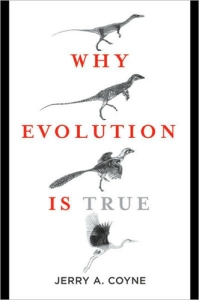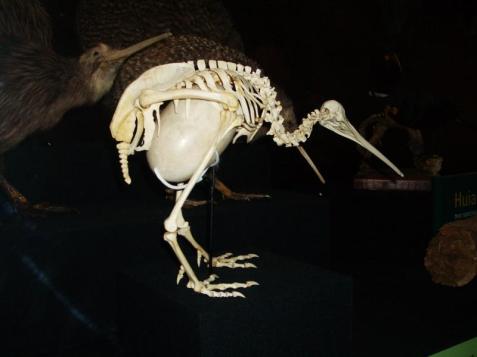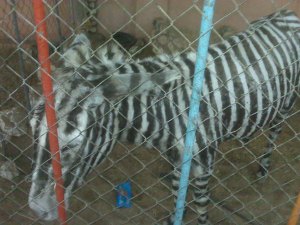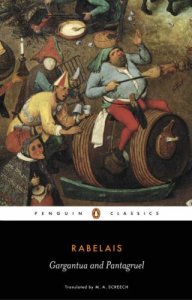 Jerry A. Coyne from the University of Chicago is a distinguished biologist of Speciation fame and a well-known figure in the intelligent design vs. evolution debate. He for some reason felt obliged to lay out the evidence for evolution, but unlike the one mentioned above, which is a highly technical textbook (co-authored with H. Allen Orr) and an embarrassingly difficult read even for professionals, Why Evolution Is True is a delightful book designed for the average reader.
Jerry A. Coyne from the University of Chicago is a distinguished biologist of Speciation fame and a well-known figure in the intelligent design vs. evolution debate. He for some reason felt obliged to lay out the evidence for evolution, but unlike the one mentioned above, which is a highly technical textbook (co-authored with H. Allen Orr) and an embarrassingly difficult read even for professionals, Why Evolution Is True is a delightful book designed for the average reader.
Isn’t this so-called ID-evolution debate already settled? Apparently not. Not in America, at any rate. While it’s not really an issue in Europe, a great number of people in the United States flatly reject evolution and literally interpret the Bible as the ultimate truth.
But here’s the thing: the evidence for evolution is overwhelming. It’s there for all to see. Paleontology, geology, plate tectonics, biogeography, comparative anatomy, genetics, molecular biology – all these disciplines have their share to add to the ever-growing pile of evidence. You have to be blind or just plain stupid to deny it.
At any rate, Dr. Coyne makes his attempt to impart this intelligence to the lay people. After explaining in the first chapter what evolution is, in the following chapters he makes his case clearly with numerous examples from the above disciplines. Chapter 2 deals with fossils, how paleontologists work, radioactive dating methods, prominent transitional fossils like Tiktaalik (fish to amphibian), Archaeopteryx (reptile to bird), Indohyus (an artiodactyl ancestor of whales). This is really just an excerpt. There are a lot more.
Chapter 3 happens to contain my favourite example, one from ontogenesis. Not the easiest to understand, but I hadn’t known about it before. I recommend medical students pop this to their anatomy teacher: why the heck does our left recurrent pharyngeal nerve go all the way down to the heart and come back only to innervate the larynx?

The answer lies in ontogenesis and common ancestry:
One of nature’s worst designs is shown by the recurrent laryngeal nerve of mammals. Running from the brain to the larynx, this nerve helps us speak and swallow. The curious thing is that it is much longer than it needs to be. Rather than taking a direct route from the brain to the larynx, a distance of about a foot in humans, the nerve runs down into our chest, loops around the aorta and a ligament derived from an artery, and then travels back up to connect to the larynx. It winds up being three feet long. In giraffes the nerve takes a similar path, but one that runs all the way down that long neck and back up again: a distance fifteen feet longer than the direct route! When I first heard about this strange nerve, I had trouble believing it. Wanting to see for myself, I mustered up my courage to make a trip to the human anatomy lab and inspect my first corpse. An obliging professor showed me the nerve, tracing its course with a pencil down the torso and back up to the throat.
This circuitous path of the recurrent laryngeal nerve is not only poor design, but might even be maladaptive. That extra length makes it more prone to injury. It can, for example, be damaged by a blow to the chest, making it hard to talk or swallow. But the pathway makes sense when we understand how the recurrent laryngeal nerve evolved. Like the mammalian aorta itself, it descends from those branchial arches of our fishlike ancestors. In the early fishlike embryos of all vertebrates, the nerve runs from top to bottom alongside the blood vessel of the sixth branchial arch; it is a branch of the larger vagus nerve that travels along the back from the brain. And in adult fish, the nerve remains in that position, connecting the brain to the gills and helping them pump water.
During our evolution, the blood vessel from the fifth arch disappeared, and the vessels from the fourth and sixth arches moved downward into the future torso so that they could become the aorta and a ligament connecting the aorta to the pulmonary artery. But the laryngeal nerve, still behind the sixth arch, had to remain connected to the embryonic structures that become the larynx, structures that remained near the brain. As the future aorta evolved backward toward the heart, the laryngeal nerve was forced to evolve backward along with it. It would have been more efficient for the nerve to detour around the aorta, breaking and then re-forming itself on a more direct course, but natural selection couldn’t manage that, for severing and rejoining a nerve is a step that reduces fitness. To keep up with the backward evolution of the aorta, the laryngeal nerve had to become long and recurrent. And that evolutionary path is recapitulated during development, since as embryos we begin with the ancestral fishlike pattern of nerves and blood vessels. In the end, we’re left with bad design.
The following chapters deal with the geography of life, how animals came to live in the separate continents, island biogeography, bees killing giant hornets by heating them up to 80 degrees centigrade, evolution in the test tube, drug resistance, a whole chapter on sexual selection, speciation (the process of distinct species formation), population genetics, human evolution (including Homo floresiensis, the hobbit), etc.
All in all, a profoundly satisfying read, a rare gem in the market of popular science books. Last words:
We are the one creature to whom natural selection has bequeathed a brain complex enough to comprehend the laws that govern the universe. And we should be proud that we are the only species that has figured out how we came to be.
 Three species of bamboo lemur exist in the same (and ever-shrinking) tiny area in Eastern Madagascar. They provide us with a singular example of adaptive radiation. All three eat bamboo, but in a very civil manner they feed on different parts of the plant. Why do they have to split the bamboo that way? Short answer: niche partitioning. A somewhat extended answer: closely related animals living in the same area (sympatric species) can not occupy the same biological niche (which can be a habitat or merely a certain type of food, like in this particular case), because sooner or later the stronger one would displace the other.
Three species of bamboo lemur exist in the same (and ever-shrinking) tiny area in Eastern Madagascar. They provide us with a singular example of adaptive radiation. All three eat bamboo, but in a very civil manner they feed on different parts of the plant. Why do they have to split the bamboo that way? Short answer: niche partitioning. A somewhat extended answer: closely related animals living in the same area (sympatric species) can not occupy the same biological niche (which can be a habitat or merely a certain type of food, like in this particular case), because sooner or later the stronger one would displace the other. Now, the gentle bamboo lemur (Hapalemur griseus) eats the leaves, while the greater bamboo lemur (H. simus), a more robust species, eats the pith of mature stalks. The golden bambo lemur (H. aureus) confines itself to the new shoots, leaf bases and the pith of narrow stems.
Now, the gentle bamboo lemur (Hapalemur griseus) eats the leaves, while the greater bamboo lemur (H. simus), a more robust species, eats the pith of mature stalks. The golden bambo lemur (H. aureus) confines itself to the new shoots, leaf bases and the pith of narrow stems. 

 What a nice zebra! Except that it’s not a zebra. It’s a donkey painted to look like a zebra. Even the ears are striped! I understand that they can’t really afford to obtain and keep expensive animals in the Gaza Strip, but I don’t think the solution is to counterfeit one. The solution is to shut down the
What a nice zebra! Except that it’s not a zebra. It’s a donkey painted to look like a zebra. Even the ears are striped! I understand that they can’t really afford to obtain and keep expensive animals in the Gaza Strip, but I don’t think the solution is to counterfeit one. The solution is to shut down the  Jerry A. Coyne from the University of Chicago is a distinguished biologist of
Jerry A. Coyne from the University of Chicago is a distinguished biologist of 
